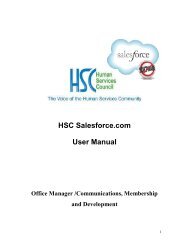BLUEPRINT
Blueprint for Neighborhoods - United Neighborhood Houses
Blueprint for Neighborhoods - United Neighborhood Houses
- No tags were found...
You also want an ePaper? Increase the reach of your titles
YUMPU automatically turns print PDFs into web optimized ePapers that Google loves.
Executive Summary<br />
AFTER MORE THAN A DECADE GOVERNED BY THE SAME MAYOR,<br />
New York City continues to grapple with large and complicated<br />
social issues, significant budgetary concerns, and persistent<br />
inequality among its diverse neighborhoods. New York City will<br />
soon elect a new Mayor who faces big questions and important choices.<br />
United Neighborhood Houses welcomes the opportunity to address some<br />
of these issues by outlining a forward-thinking set of policies that will<br />
strengthen our neighborhoods and move our city toward being a place<br />
that truly meets the needs of residents from a variety of economic and<br />
ethnic backgrounds.<br />
Approximately 250 neighborhoods make up New York City – each distinct and<br />
vibrant in its own way in a city with a broad range of income levels, ages, ethnicities,<br />
and places of birth. As it slowly emerges from the Great Recession, New<br />
York City continues to confront stubborn, if not deepening, inequality among its<br />
residents and neighborhoods. Nearly half of New Yorkers were pushed into or<br />
perilously close to poverty in 2011, a full two years after the official end of the<br />
Recession – a troubling indicator of how much residents continue to struggle 1 .<br />
New Yorkers, including many who are employed, have faced a multitude of challenges<br />
as their incomes stagnated and the nation’s economy contracted.<br />
The disparity is stark: New York City is home to both the nation’s wealthiest and<br />
its poorest Congressional district, separated by only three miles 2 . While not far<br />
apart, residents of these two locales can appear to live in different worlds: a baby<br />
born on Manhattan’s Upper East Side (the nation’s wealthiest Congressional district<br />
per capita) has a life expectancy a full four years higher than one born in the<br />
South Bronx (the nation’s poorest Congressional district) 3 . This inequity determines<br />
the level of opportunity available to residents and their ability to build a<br />
productive future for themselves and their families.<br />
For over a century, settlement houses have been an important stabilizing force<br />
for individuals and families citywide. Their importance was thrown into high<br />
relief by Hurricane Sandy, which brought unprecedented challenges to New York<br />
City’s neighborhoods and reinforced the value of UNH member organizations as<br />
anchor institutions in their communities. This critical role has only been accentuated<br />
in these difficult economic times as settlement houses have seen increasing<br />
demand for their programs while government funding for neighborhood services<br />
has steadily declined. The disconnect between residents’ needs for comprehensive<br />
neighborhood-based services and the shrinking funding available to meet these<br />
needs is leaving residents, communities and the nonprofit sector as a whole in an<br />
escalating crisis and the City in dire need of solutions.<br />
New York City needs a new approach and a broader vision. If New York City is to<br />
truly emerge from the Recession and thrive as an economic and cultural center, it<br />
is critical that the next Administration implements policies and invests in programs<br />
that support and enhance the opportunities available to all residents. As Federal<br />
and State funding continues to decrease, City leaders must prioritize identifying<br />
additional revenue through progressive tax structures in order to invest in communities<br />
and the neighborhood-based organizations that sustain them.<br />
It is a time for solutions, and for a plan. Informed by a series of community visioning<br />
sessions conducted by United Neighborhood Houses in neighborhoods across<br />
Blueprint for Neighborhoods 2013 2




